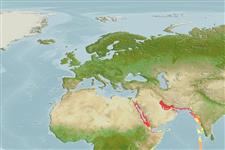Classificação / Names
Nomes comuns | Sinônimos | Catalog of Fishes(Gênero, Espécies) | ITIS | CoL | WoRMS | Cloffa
>
Pleuronectiformes (Flatfishes) >
Soleidae (Soles)
Etymology: Aseraggodes: Greek, aggos, -eos, -ous = vessel, uterus, carapace of a crab + Greek, aseros, -a, -on = to remove the appetite (Ref. 45335).
More on author: Chabanaud.
Environment: milieu / climate zone / depth range / distribution range
Ecologia
marinhas demersal; intervalo de profundidade 35 - 68 m (Ref. 57561). Tropical
Western Indian Ocean: Red Sea.
Tamanho / Peso / Idade
Maturity: Lm ? range ? - ? cm
Max length : 7.9 cm SL macho/indeterminado; (Ref. 57561)
Descrição suscinta
Morfologia | Morfometria
Raios dorsais (total): 59-67; Raios anais : 40 - 45; Vértebras: 35. Diagnosis: Dorsal rays 62 (59-67); anal rays 43 (40-45); dorsal and anal rays unbranched; caudal rays 18, the upper 3 and lower 2 unbranched, the remaining rays mostly double branched; pelvic rays 5, unbranched; lateral-line scales 62 (62-72), including 8 (7-10) anterior to upper end of gill opening; lateral line projecting anteriorly toward dorsal edge of upper eye; vertebrae 35 (5 specimens) to 36 (5 specimens); dorsal pterygiophores anterior to fourth neural spine 10-11 (one of nine with 10); body depth 2.3-2.7 in SL; head length (HL) 3.45-4.15 in SL. Remaining measurements just for lectotype: snout 3.05 in HL; preorbital length 3.5 in HL; eye diameter 6.95 in HL; interorbital space 16.5 in HL; tubular anterior nostril short, not reaching cutaneous anterior edge of eye when laid back; maxilla extending posterior to a vertical through middle of lower eye, the upper-jaw length 3.8 in HL; upper end of gill opening on a horizontal passing through ventral edge of lower eye; cirri on front of snout and ventral side of head slender and small; slender cirri along edge of operculum at gill opening on blind side; no cirri detected on dorsal or anal rays; no caudal peduncle depth of caudal-fin base 1.7 in HL; longest dorsal and anal rays 1.6 in HL; caudal fin short, 4.3 in SL; pelvic-fins just reaching base of second anal ray, the ocular-side pelvic fin longer; longest pelvic ray 2.7 in HL; color of ocular side of lectotype tan, the fins pale yellowish; color in formalin as reported: very pale, uniformly and densely dotted with brown, with some larger dots of the same shade of brown, especially on fins (Ref. 57561).
Ciclo de vida ou comportamento de acasalamento
Maturidade | Reprodução | Desova | Ovos | Fecundidade | Larvas
Goren, M. and M. Dor, 1994. An updated checklist of the fishes of the Red Sea (CLOFRES II). The Israel Academy of Sciences and Humanities, Jerusalem, Israel. 120 p. (Ref. 12541)
Status na Lista Vermelha da UICN (Ref. 130435)
Ameaça para os humanos
Harmless
Uso pelos humanos
Mais informação
Nomes comunsSinônimosMetabolismoPredadoresEcotoxicologiaReproduçãoMaturidadeDesovaAgregação de desovaFecundidadeOvosDesenvolvimento dos ovos
Idade/TamanhoCrescimentoPeso-comprimentoComprimento-comprimentoFrequências de comprimentoMorfometriaMorfologiaLarvasDinâmica larvalRecrutamentoAbundânciaBRUVS
ReferênciasAquaculturaPerfil para aquaculturaEstirpesGenéticaElectrophoresesHereditariedadeDoençasProcessamentoNutrientsConversão de massa
ColaboradoresFotosStamps, Coins Misc.SonsCiguateraVelocidadeTipo de nataçãoÁrea branquialOtólitosCérebrosVisão
Ferramentas
Relatórios especiais
Baixar XML
Fontes da internet
Estimates based on models
Preferred temperature (Ref.
123201): 22.3 - 28.2, mean 23.6 °C (based on 20 cells).
Índice de diversidade filogenética (Ref.
82804): PD
50 = 0.5000 [Uniqueness, from 0.5 = low to 2.0 = high].
Bayesian length-weight: a=0.00977 (0.00473 - 0.02021), b=3.07 (2.90 - 3.24), in cm total length, based on LWR estimates for this (Sub)family-body shape (Ref.
93245).
Nível Trófico (Ref.
69278): 3.5 ±0.5 se; based on size and trophs of closest relatives
Resiliência (Ref.
120179): Elevada, tempo mínimo de duplicação da população menor que 15 meses (Preliminary K or Fecundity.).
Fishing Vulnerability (Ref.
59153): Low vulnerability (10 of 100).
